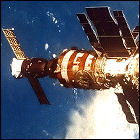 The Soviet Union launches Soyuz T-13 on a mission to salvage space station Salyut 7, which has gone unoccupied for more than half a year and has lost power and attitude control. Cosmonauts Vladimir Dzhanibekov and Viktor Savinykh find the station dead in space, tumbling slowly, forcing them to use their Soyuz vehicle’s thrusters to match the station’s erratic motion to allow a manual docking. Inside the station, the crew finds frigid but breathable air, and again the Soyuz engines are fired to orient the station so its solar panels catch enough sunlight to charge its batteries. After a week of work carried out in bulky clothing befitting a Russian winter, the cosmonauts reactivate the station fully, scoring a major space first – the first-ever docking with, and repair of, a fully deactivated space station. For the first time, a Salyut crew spends some overlap time with the next long-term crew, a step toward the uninterrupted occupancy that will become commonplace aboard Mir, Salyut’s successor. Savinykh remains aboard Salyut 7 for 168 days, overlapping into the next long-term station crew, while Dzhanibekov departs 110 days into his stay.
The Soviet Union launches Soyuz T-13 on a mission to salvage space station Salyut 7, which has gone unoccupied for more than half a year and has lost power and attitude control. Cosmonauts Vladimir Dzhanibekov and Viktor Savinykh find the station dead in space, tumbling slowly, forcing them to use their Soyuz vehicle’s thrusters to match the station’s erratic motion to allow a manual docking. Inside the station, the crew finds frigid but breathable air, and again the Soyuz engines are fired to orient the station so its solar panels catch enough sunlight to charge its batteries. After a week of work carried out in bulky clothing befitting a Russian winter, the cosmonauts reactivate the station fully, scoring a major space first – the first-ever docking with, and repair of, a fully deactivated space station. For the first time, a Salyut crew spends some overlap time with the next long-term crew, a step toward the uninterrupted occupancy that will become commonplace aboard Mir, Salyut’s successor. Savinykh remains aboard Salyut 7 for 168 days, overlapping into the next long-term station crew, while Dzhanibekov departs 110 days into his stay.
Hear about it on the Sci-Fi 5 podcast
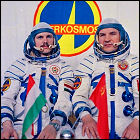 Soyuz 36 is launched by the Soviet Union on a one-week mission to space station Salyut 6. The crew consists of Apollo-Soyuz veteran Valery Kubasov and the first Hungarian in space, Bertalan Farkas. During the crew’s week-long visit to Salyut 6, they undertake an exhaustingly jam-packed series of experiments before swapping Soyuz vehicles with the long-duration station crew – technically, the Soyuz 36 crew returns in the Soyuz 35 vehicle on June 6th.
Soyuz 36 is launched by the Soviet Union on a one-week mission to space station Salyut 6. The crew consists of Apollo-Soyuz veteran Valery Kubasov and the first Hungarian in space, Bertalan Farkas. During the crew’s week-long visit to Salyut 6, they undertake an exhaustingly jam-packed series of experiments before swapping Soyuz vehicles with the long-duration station crew – technically, the Soyuz 36 crew returns in the Soyuz 35 vehicle on June 6th.
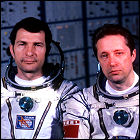 An advanced version of a new Soviet Soyuz spacecraft is launched with a crew for the first time. Soyuz T-2 is launched on a three-day mission to visit the Salyut 6 space station, with its primary goal to test a new automated approach and docking system for use with the Salyut space stations. After spending almost four days in orbit, cosmonauts Yuri Malyshev and Vladimir Aksyonov return to Earth; due to their vehicle’s flight test status, the T-2 crew does not swap spacecraft with the Salyut 6/Soyuz 35 crew.
An advanced version of a new Soviet Soyuz spacecraft is launched with a crew for the first time. Soyuz T-2 is launched on a three-day mission to visit the Salyut 6 space station, with its primary goal to test a new automated approach and docking system for use with the Salyut space stations. After spending almost four days in orbit, cosmonauts Yuri Malyshev and Vladimir Aksyonov return to Earth; due to their vehicle’s flight test status, the T-2 crew does not swap spacecraft with the Salyut 6/Soyuz 35 crew.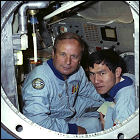 The Soviet Union launches Soyuz 37 on a week-long mission to visit space station Salyut 6. Part of the Interkosmos series, Soyuz 37 carries an international crew consisting of veteran cosmonaut Viktor Gorbatko and the first Vietnamese space traveler, Pham Tuan. Joint experiments are conducted with the long-duration crew of Salyut 6/Soyuz 35, and the Soyuz 37 crew departs in the Soyuz 36 capsule on July 31st, leaving the station crew with a fresh vehicle with which to make their own return home.
The Soviet Union launches Soyuz 37 on a week-long mission to visit space station Salyut 6. Part of the Interkosmos series, Soyuz 37 carries an international crew consisting of veteran cosmonaut Viktor Gorbatko and the first Vietnamese space traveler, Pham Tuan. Joint experiments are conducted with the long-duration crew of Salyut 6/Soyuz 35, and the Soyuz 37 crew departs in the Soyuz 36 capsule on July 31st, leaving the station crew with a fresh vehicle with which to make their own return home.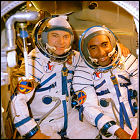 The Soviet Union launches Soyuz 38 on a mission to the Salyut 6 space station, carrying cosmonaut Yuri Romanenko and the first Cuban in space, Arnaldo Tamayo Mendez. The week-long flight includes docking maneuvers with Salyut 6 in pitch blackness, guided only by the lights on both the Soyuz vehicle and the station, and experiments aboard Salyut. Since the long-duration Salyut 6/Soyuz 35 crew is due to leave the station soon, the Soyuz 38 crew departs in the same vehicle in which it arrived.
The Soviet Union launches Soyuz 38 on a mission to the Salyut 6 space station, carrying cosmonaut Yuri Romanenko and the first Cuban in space, Arnaldo Tamayo Mendez. The week-long flight includes docking maneuvers with Salyut 6 in pitch blackness, guided only by the lights on both the Soyuz vehicle and the station, and experiments aboard Salyut. Since the long-duration Salyut 6/Soyuz 35 crew is due to leave the station soon, the Soyuz 38 crew departs in the same vehicle in which it arrived.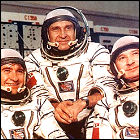 Soyuz T-3 lifts off from the Soviet Union’s Baikonur Cosmodrome launch complex, carrying the first three-man Soviet space crew since the early days of the Soyuz in 1971. Cosmonauts Leonid Kizim, Oleg Makarov and Gennady Strekalov also become the first three-man space station crew since the ill-fated crew of the first Salyut. Over a period of nearly two weeks, the crew conducts extensive repairs and upgrades to Salyut 6, readying the station for its next long-duration crew before departing on December 10th.
Soyuz T-3 lifts off from the Soviet Union’s Baikonur Cosmodrome launch complex, carrying the first three-man Soviet space crew since the early days of the Soyuz in 1971. Cosmonauts Leonid Kizim, Oleg Makarov and Gennady Strekalov also become the first three-man space station crew since the ill-fated crew of the first Salyut. Over a period of nearly two weeks, the crew conducts extensive repairs and upgrades to Salyut 6, readying the station for its next long-duration crew before departing on December 10th.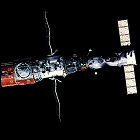 The Soyuz T-4 mission lifts off from the Soviet Union, carrying a two-man crew to space station Salyut 6. Cosmonauts Vladimir Kovalyonok and Viktor Savinykh remain about the station for 75 days, and are the last long-duration crew to occupy Salyut 6. Since they are still in orbit in April, they become the first Soviet crew to orbit the Earth at the same time as an American manned space vehicle since 1975, though the two never interact with each other at any point. The Soyuz T-4 capsule remains at the station as the escape vehicle until this crew departs in May.
The Soyuz T-4 mission lifts off from the Soviet Union, carrying a two-man crew to space station Salyut 6. Cosmonauts Vladimir Kovalyonok and Viktor Savinykh remain about the station for 75 days, and are the last long-duration crew to occupy Salyut 6. Since they are still in orbit in April, they become the first Soviet crew to orbit the Earth at the same time as an American manned space vehicle since 1975, though the two never interact with each other at any point. The Soyuz T-4 capsule remains at the station as the escape vehicle until this crew departs in May.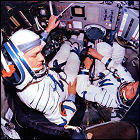 Soyuz 39 lifts off from the Soviet Union, carrying its two-man crew on a week-long spaceflight including a visit to space station Salyut 6. The crew consists of cosmonauts Vladimir Dzhanibekov and Jugderdemidiin Gurragchaa, the first Mongolian in space. In conjunction with the resident Salyut 6/Soyuz T-4 crew, they conduct scientific and engineering experiments, some of them studying the state of Salyut 6 after several years in orbit. The Soyuz 39 crew returns to Earth on March 30th.
Soyuz 39 lifts off from the Soviet Union, carrying its two-man crew on a week-long spaceflight including a visit to space station Salyut 6. The crew consists of cosmonauts Vladimir Dzhanibekov and Jugderdemidiin Gurragchaa, the first Mongolian in space. In conjunction with the resident Salyut 6/Soyuz T-4 crew, they conduct scientific and engineering experiments, some of them studying the state of Salyut 6 after several years in orbit. The Soyuz 39 crew returns to Earth on March 30th.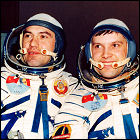 The final first-generation Soyuz spacecraft, Soyuz 40, is launched on a week-long spaceflight by the Soviet Union. With Leonid Popov and Romanian cosmonaut Dumitru Prunariu aboard, Soyuz 40 visits space station Salyut 6 for several days, and is the last spacecraft to dock at the five-year-old space station. The Soyuz 40 crew returns to Earth on May 22nd. Future Soyuz launches will use the upgraded Soyuz-T vehicles.
The final first-generation Soyuz spacecraft, Soyuz 40, is launched on a week-long spaceflight by the Soviet Union. With Leonid Popov and Romanian cosmonaut Dumitru Prunariu aboard, Soyuz 40 visits space station Salyut 6 for several days, and is the last spacecraft to dock at the five-year-old space station. The Soyuz 40 crew returns to Earth on May 22nd. Future Soyuz launches will use the upgraded Soyuz-T vehicles.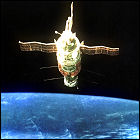 Launched unmanned in April, the Kosmos 1267 space station module docks automatically with the recently vacated Salyut 6 space station – the first-ever on-orbit expansion of a previously launched space structure. The module, a hardware holdover from the abandoned Almaz military space station program, provides engineers on the ground with information needed to safely add modules to the upcoming Salyut 7 space station to expand its habitable space. The experience gained will also be instrumental in the construction of the Mir station and the International Space Station. Kosmos 1267 remains docked to Salyut 6 until the combined structure tumbles out of orbit in 1982.
Launched unmanned in April, the Kosmos 1267 space station module docks automatically with the recently vacated Salyut 6 space station – the first-ever on-orbit expansion of a previously launched space structure. The module, a hardware holdover from the abandoned Almaz military space station program, provides engineers on the ground with information needed to safely add modules to the upcoming Salyut 7 space station to expand its habitable space. The experience gained will also be instrumental in the construction of the Mir station and the International Space Station. Kosmos 1267 remains docked to Salyut 6 until the combined structure tumbles out of orbit in 1982.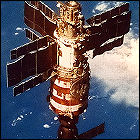 The Soviet Union launches the last of the Salyut space stations, Salyut 7, into Earth orbit. Reflecting an ongoing significant rethink on space station construction, Salyut 7 is intended from the outset to be docked with additional modules to expand its habitable and working space. It also sets a new endurance record of its own, remaining in orbit for nearly a decade.
The Soviet Union launches the last of the Salyut space stations, Salyut 7, into Earth orbit. Reflecting an ongoing significant rethink on space station construction, Salyut 7 is intended from the outset to be docked with additional modules to expand its habitable and working space. It also sets a new endurance record of its own, remaining in orbit for nearly a decade.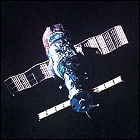 Soyuz T-5 lifts off from the Soviet Union, carrying its crew of two to the new Salyut 7 space station for a long-term stay. Cosmonauts Anatoli Berezovoy and Valentin Lebedev become Salyut 7’s first occupants, remaining aboard the station for a record-setting 211 days (almost seven months), not returning until December 1982. During that time, the two cosmonauts host two other visiting crews and launch a small amateur radio communications satellite by ejecting it from a small airlock.
Soyuz T-5 lifts off from the Soviet Union, carrying its crew of two to the new Salyut 7 space station for a long-term stay. Cosmonauts Anatoli Berezovoy and Valentin Lebedev become Salyut 7’s first occupants, remaining aboard the station for a record-setting 211 days (almost seven months), not returning until December 1982. During that time, the two cosmonauts host two other visiting crews and launch a small amateur radio communications satellite by ejecting it from a small airlock.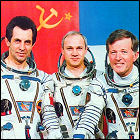 The Soviet Union launches the Soyuz T-6 mission on a week-long flight into orbit, including a visit to space station Salyut 7. Cosmonauts Vladimir Dzhanibekov, Aleksandr Ivanchenkov and Jean-Loup Chretien – the latter being the first Frenchman in space – spend several days aboard Salyut 7 performing experiments. Chretien would fly on later missions aboard Mir and the American Space Shuttle.
The Soviet Union launches the Soyuz T-6 mission on a week-long flight into orbit, including a visit to space station Salyut 7. Cosmonauts Vladimir Dzhanibekov, Aleksandr Ivanchenkov and Jean-Loup Chretien – the latter being the first Frenchman in space – spend several days aboard Salyut 7 performing experiments. Chretien would fly on later missions aboard Mir and the American Space Shuttle.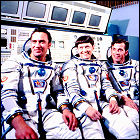 The Soviet Union’s Soyuz T-7 mission lifts off from Baikonur Cosmodrome for a week-long stay in space, including a visit to space station Salyut 7. The three-person Soyuz crew includes the first woman in space since 1963. Cosmonauts Leonid Popov, Aleksandr Serebrov and Svetlana Savitskaya deliver supplies to Salyut 7 and perform experiments while docked to the station; on August 27th, they depart from the station aboard the Soyuz T-5 vehicle, leaving the newer T-7 capsule for the station crew’s use.
The Soviet Union’s Soyuz T-7 mission lifts off from Baikonur Cosmodrome for a week-long stay in space, including a visit to space station Salyut 7. The three-person Soyuz crew includes the first woman in space since 1963. Cosmonauts Leonid Popov, Aleksandr Serebrov and Svetlana Savitskaya deliver supplies to Salyut 7 and perform experiments while docked to the station; on August 27th, they depart from the station aboard the Soyuz T-5 vehicle, leaving the newer T-7 capsule for the station crew’s use.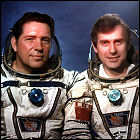 Soyuz T-9 lifts off from the Soviet Union, bringing a new long-term crew to space station Salyut 7. Cosmonauts Vladimir Lyakhov and Aleksandr Aleksandrov take up residence on Salyut 7 for a 150-day stay, including work aboard the recently-docked Kosmos 1443 temporary space station module. The disastrous failure of the next Soyuz mission to reach orbit means that Lyakhov and Aleksandrov spend their entire stay in orbit with no visits from other crews. They return to Earth on November 23rd.
Soyuz T-9 lifts off from the Soviet Union, bringing a new long-term crew to space station Salyut 7. Cosmonauts Vladimir Lyakhov and Aleksandr Aleksandrov take up residence on Salyut 7 for a 150-day stay, including work aboard the recently-docked Kosmos 1443 temporary space station module. The disastrous failure of the next Soyuz mission to reach orbit means that Lyakhov and Aleksandrov spend their entire stay in orbit with no visits from other crews. They return to Earth on November 23rd.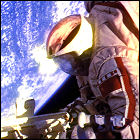 Delayed many months during the investigation into the causes of the Soyuz T-10a near-disaster in 1983, Soyuz T-10 lifts off from the Soviet Union. Cosmonauts Leonid Kizim, Vladimir Solovyov and Oleg Atkov take up residence on space station Salyut 7 for a 236-day stay – the longest duration crew of the entire Salyut space station program – during which they have to conduct repairs to the station both inside and outside in a series of spacewalks. Left unoccupied months longer than expected, the station has powered down and must be reactivated, a process taking nearly ten days. A fuel line break on the exterior of the station must be repaired as well. The crew remains aboard Salyut 7 through October.
Delayed many months during the investigation into the causes of the Soyuz T-10a near-disaster in 1983, Soyuz T-10 lifts off from the Soviet Union. Cosmonauts Leonid Kizim, Vladimir Solovyov and Oleg Atkov take up residence on space station Salyut 7 for a 236-day stay – the longest duration crew of the entire Salyut space station program – during which they have to conduct repairs to the station both inside and outside in a series of spacewalks. Left unoccupied months longer than expected, the station has powered down and must be reactivated, a process taking nearly ten days. A fuel line break on the exterior of the station must be repaired as well. The crew remains aboard Salyut 7 through October.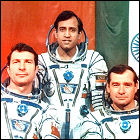 The Soviet Union launches Soyuz T-11 en route to space station Salyut 7. Spending nearly eight days in orbit, cosmonauts Yuri Malyshev, Gennady Strekalov and the first space traveler from India, Rakesh Sharma, perform experiments aboard the station as well as bringing supplies. They return to Earth on April 11th aboard the station crew’s Soyuz T-10 capsule, leaving the newer Soyuz T-11 docked at Salyut 7 for the station crew’s use.
The Soviet Union launches Soyuz T-11 en route to space station Salyut 7. Spending nearly eight days in orbit, cosmonauts Yuri Malyshev, Gennady Strekalov and the first space traveler from India, Rakesh Sharma, perform experiments aboard the station as well as bringing supplies. They return to Earth on April 11th aboard the station crew’s Soyuz T-10 capsule, leaving the newer Soyuz T-11 docked at Salyut 7 for the station crew’s use.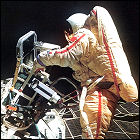 The Soviet Union launches Soyuz T-12 on a mission to space station Salyut 7. Cosmonauts Vladimir Dzhanibekov, Svetlana Savitskaya and Igor Volk visit the station crew and test new equipment during a three-hour spacewalk. Savitskaya becomes the first woman to fly in space twice as well as the first female spacewalker, an assignment that seems to have been devised purely for the political purpose of beating NASA to that first (the American space agency having announced in 1983 that an upcoming shuttle mission would feature a female spacewalker). Volk’s presence aboard the mission ensures that he has spaceflight experience ahead of his next mission, believed to be the first manned flight of the Soviet Buran shuttle. The Soyuz T-12 crew is in space for almost 12 days, returning to Earth on July 29th.
The Soviet Union launches Soyuz T-12 on a mission to space station Salyut 7. Cosmonauts Vladimir Dzhanibekov, Svetlana Savitskaya and Igor Volk visit the station crew and test new equipment during a three-hour spacewalk. Savitskaya becomes the first woman to fly in space twice as well as the first female spacewalker, an assignment that seems to have been devised purely for the political purpose of beating NASA to that first (the American space agency having announced in 1983 that an upcoming shuttle mission would feature a female spacewalker). Volk’s presence aboard the mission ensures that he has spaceflight experience ahead of his next mission, believed to be the first manned flight of the Soviet Buran shuttle. The Soyuz T-12 crew is in space for almost 12 days, returning to Earth on July 29th. The Soviet Union launches Soyuz T-13 on a mission to salvage space station Salyut 7, which has gone unoccupied for more than half a year and has lost power and attitude control. Cosmonauts Vladimir Dzhanibekov and Viktor Savinykh find the station dead in space, tumbling slowly, forcing them to use their Soyuz vehicle’s thrusters to match the station’s erratic motion to allow a manual docking. Inside the station, the crew finds frigid but breathable air, and again the Soyuz engines are fired to orient the station so its solar panels catch enough sunlight to charge its batteries. After a week of work carried out in bulky clothing befitting a Russian winter, the cosmonauts reactivate the station fully, scoring a major space first – the first-ever docking with, and repair of, a fully deactivated space station. For the first time, a Salyut crew spends some overlap time with the next long-term crew, a step toward the uninterrupted occupancy that will become commonplace aboard Mir, Salyut’s successor. Savinykh remains aboard Salyut 7 for 168 days, overlapping into the next long-term station crew, while Dzhanibekov departs 110 days into his stay.
The Soviet Union launches Soyuz T-13 on a mission to salvage space station Salyut 7, which has gone unoccupied for more than half a year and has lost power and attitude control. Cosmonauts Vladimir Dzhanibekov and Viktor Savinykh find the station dead in space, tumbling slowly, forcing them to use their Soyuz vehicle’s thrusters to match the station’s erratic motion to allow a manual docking. Inside the station, the crew finds frigid but breathable air, and again the Soyuz engines are fired to orient the station so its solar panels catch enough sunlight to charge its batteries. After a week of work carried out in bulky clothing befitting a Russian winter, the cosmonauts reactivate the station fully, scoring a major space first – the first-ever docking with, and repair of, a fully deactivated space station. For the first time, a Salyut crew spends some overlap time with the next long-term crew, a step toward the uninterrupted occupancy that will become commonplace aboard Mir, Salyut’s successor. Savinykh remains aboard Salyut 7 for 168 days, overlapping into the next long-term station crew, while Dzhanibekov departs 110 days into his stay.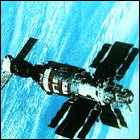 The Soviet Union launches the Soyuz T-14 mission, carrying a crew of three cosmonauts intended to become the next long-term occupants of space station Salyut 7. The crew consists of Vladimir Vasyutin, Georgi Grechko and Alexander Volkov, though Grechko only remains until September 26th, returning to Earth with the Soyuz T-13 crew. Two months into the crew’s stay on Salyut, however, Vasyutin becomes seriously ill. Communications between the station and ground controllers are carried out on a scrambled frequency for a week, at which point the crew is recalled to Earth, ending an occupancy that was meant to last for half a year. Soyuz T-14 returns to Earth, carring Vasyutin, Volkov and Soyuz T-13 crew member Viktor Savinykh home on November 21st, once again leaving Salyut 7 unoccupied for several months.
The Soviet Union launches the Soyuz T-14 mission, carrying a crew of three cosmonauts intended to become the next long-term occupants of space station Salyut 7. The crew consists of Vladimir Vasyutin, Georgi Grechko and Alexander Volkov, though Grechko only remains until September 26th, returning to Earth with the Soyuz T-13 crew. Two months into the crew’s stay on Salyut, however, Vasyutin becomes seriously ill. Communications between the station and ground controllers are carried out on a scrambled frequency for a week, at which point the crew is recalled to Earth, ending an occupancy that was meant to last for half a year. Soyuz T-14 returns to Earth, carring Vasyutin, Volkov and Soyuz T-13 crew member Viktor Savinykh home on November 21st, once again leaving Salyut 7 unoccupied for several months.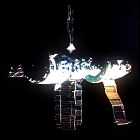 The unmanned Kosmos 1686 module, launched by the Soviet Union in September, successfully completes an automated docking with space station Salyut 7. This new module is a permanent addition to the final Salyut station, offering more habitable space for work and storage aboard the aging station. Kosmos 1686 arrives with nearly 10,000 pounds of supplies and consumables, and serves as a case study to help engineers plan the upcoming Mir space station, which is designed from the outset to consist of several add-on modules.
The unmanned Kosmos 1686 module, launched by the Soviet Union in September, successfully completes an automated docking with space station Salyut 7. This new module is a permanent addition to the final Salyut station, offering more habitable space for work and storage aboard the aging station. Kosmos 1686 arrives with nearly 10,000 pounds of supplies and consumables, and serves as a case study to help engineers plan the upcoming Mir space station, which is designed from the outset to consist of several add-on modules.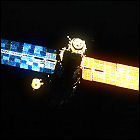 The Soviet Union launches Soyuz T-15 on an unprecedented mission into orbit. Cosmonauts Leonid Kizim and Vladimir Solovyov become the first occupants of the newly-launched Mir space station on March 15th, where they remain until early May, at which time they undock the Soyuz T-15 vehicle from Mir and visit the powered-down Salyut 7 space station, becoming its final occupants until they return to Mir in late June, bringing several pieces of equipment and experiments cannibalized from Salyut back with them. The crew spends a total of 125 days in space, at the end of which Kizim is the most-traveled man in space, having accumulated over a year of total space travel time. Soyut T-15 is the last second-generation Soyuz vehicle to fly, returning to Earth on July 16th.
The Soviet Union launches Soyuz T-15 on an unprecedented mission into orbit. Cosmonauts Leonid Kizim and Vladimir Solovyov become the first occupants of the newly-launched Mir space station on March 15th, where they remain until early May, at which time they undock the Soyuz T-15 vehicle from Mir and visit the powered-down Salyut 7 space station, becoming its final occupants until they return to Mir in late June, bringing several pieces of equipment and experiments cannibalized from Salyut back with them. The crew spends a total of 125 days in space, at the end of which Kizim is the most-traveled man in space, having accumulated over a year of total space travel time. Soyut T-15 is the last second-generation Soyuz vehicle to fly, returning to Earth on July 16th.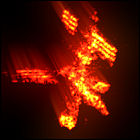 The last of the Salyut space stations from the heyday of the Soviet space program, Salyut 7 tumbles into the Earth’s atmosphere, its supply of fuel exhausted. (No cosmonauts have occupied Salyut 7 since 1986.) With the large Kosmos 1686 expansion still docked, most of Salyut 7 disintegrates in the atmosphere, though some debris is scattered over Argentina. Salyut 7 lasted nearly nine years in orbit.
The last of the Salyut space stations from the heyday of the Soviet space program, Salyut 7 tumbles into the Earth’s atmosphere, its supply of fuel exhausted. (No cosmonauts have occupied Salyut 7 since 1986.) With the large Kosmos 1686 expansion still docked, most of Salyut 7 disintegrates in the atmosphere, though some debris is scattered over Argentina. Salyut 7 lasted nearly nine years in orbit.